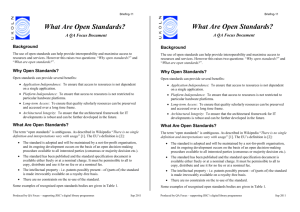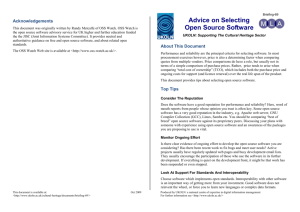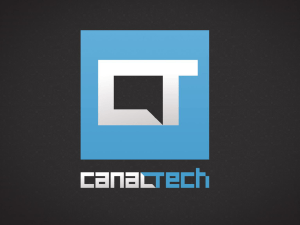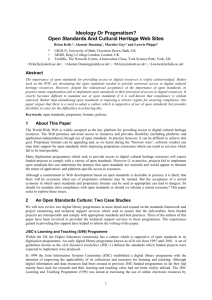What Are Open Standards?
advertisement
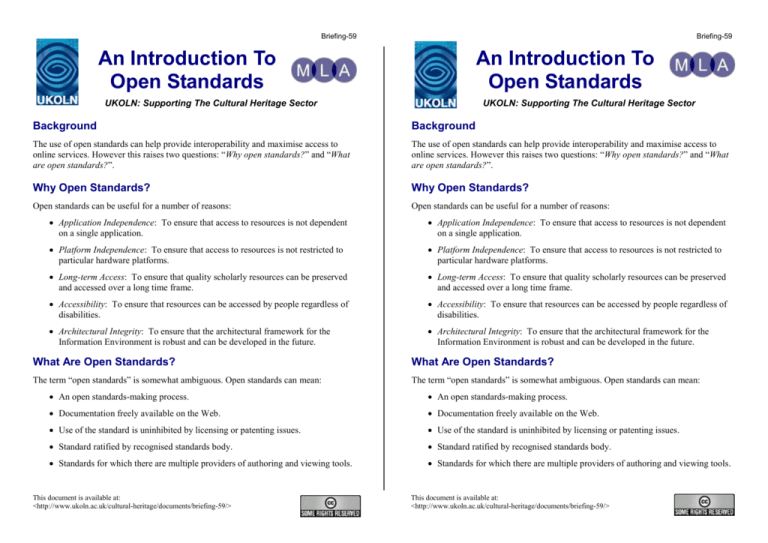
Briefing-59 Briefing-59 An Introduction To Open Standards An Introduction To Open Standards UKOLN: Supporting The Cultural Heritage Sector UKOLN: Supporting The Cultural Heritage Sector Background Background The use of open standards can help provide interoperability and maximise access to online services. However this raises two questions: “Why open standards?” and “What are open standards?”. The use of open standards can help provide interoperability and maximise access to online services. However this raises two questions: “Why open standards?” and “What are open standards?”. Why Open Standards? Why Open Standards? Open standards can be useful for a number of reasons: Open standards can be useful for a number of reasons: Application Independence: To ensure that access to resources is not dependent on a single application. Application Independence: To ensure that access to resources is not dependent on a single application. Platform Independence: To ensure that access to resources is not restricted to particular hardware platforms. Platform Independence: To ensure that access to resources is not restricted to particular hardware platforms. Long-term Access: To ensure that quality scholarly resources can be preserved and accessed over a long time frame. Long-term Access: To ensure that quality scholarly resources can be preserved and accessed over a long time frame. Accessibility: To ensure that resources can be accessed by people regardless of disabilities. Accessibility: To ensure that resources can be accessed by people regardless of disabilities. Architectural Integrity: To ensure that the architectural framework for the Information Environment is robust and can be developed in the future. Architectural Integrity: To ensure that the architectural framework for the Information Environment is robust and can be developed in the future. What Are Open Standards? What Are Open Standards? The term “open standards” is somewhat ambiguous. Open standards can mean: The term “open standards” is somewhat ambiguous. Open standards can mean: An open standards-making process. An open standards-making process. Documentation freely available on the Web. Documentation freely available on the Web. Use of the standard is uninhibited by licensing or patenting issues. Use of the standard is uninhibited by licensing or patenting issues. Standard ratified by recognised standards body. Standard ratified by recognised standards body. Standards for which there are multiple providers of authoring and viewing tools. Standards for which there are multiple providers of authoring and viewing tools. This document is available at: <http://www.ukoln.ac.uk/cultural-heritage/documents/briefing-59/> This document is available at: <http://www.ukoln.ac.uk/cultural-heritage/documents/briefing-59/> Some examples of recognised open standards bodies are given in Table 1. Organisation Some examples of recognised open standards bodies are given in Table 1. Comments Organisation Comments W3C World Wide Web Consortium (W3C). Responsible for development of Web standards (known as Recommendations). See <http://www.w3.org/TR/>. Standards include HTML, XML and CSS. W3C World Wide Web Consortium (W3C). Responsible for development of Web standards (known as Recommendations) . See <http://www.w3.org/TR/>. Standards include HTML, XML and CSS. IETF Internet Engineering Task Force (IETF). Responsible for the development of Internet standards (known as IETF RFCS). See <http://www.ietf.org/rfc.html>. Standards include HTTP, MIME, etc. IETF Internet Engineering Task Force (IETF). Responsible for the development of Internet standards (known as IETF RFCS) . See <http://www.ietf.org/rfc.html>. Standards include HTTP, MIME, etc. ISO International Organisation For Standardization (ISO). See <http://www.iso.org/iso/en/stdsdevelopment/whowhenhow/how.html>. Relevant standards areas include character sets, networking, etc. ISO International Organisation For Standardization (ISO). See <http://www.iso.org/iso/en/stdsdevelopment/whowhenhow/how.html>. Relevant standards areas include character sets, networking, etc. NISO National Information Standards Organization (NISO). See <http://www.niso.org/>. Relevant standards include Z39.50. NISO National Information Standards Organization (NISO). See <http://www.niso.org/>. Relevant standards include Z39.50. IEEE Institute of Electrical and Electronics Engineers (IEEE). See <http://www.ieee.org/>. IEEE Institute of Electrical and Electronics Engineers (IEEE). See <http://www.ieee.org/>. ECMA ECMA International. Association responsible for the standardisation of Information and Communication Technology Systems (such as JavaScript). See <http://www.ecma-international.org/>. Table 1: Examples of Open Standards Organisations ECMA International. Association responsible for the standardisation of Information and Communication Technology Systems (such as JavaScript). See <http://www.ecma-international.org/>. Table 1: Examples of Open Standards Organisations Other Types Of Standards Other Types Of Standards The term proprietary refers to formats which are owned by an organisation, group, etc. Unfortunately since this term has negative connotations, the term industry standard is often used to refer to a widely used proprietary standard e.g., the Microsoft Excel format may be described as an industry standard for spreadsheets. The term proprietary refers to formats which are owned by an organisation, group, etc. Unfortunately since this term has negative connotations, the term industry standard is often used to refer to a widely used proprietary standard e.g., the Microsoft Excel format may be described as an industry standard for spreadsheets. To further confuse matters, companies which own proprietary formats may choose to make the specification freely available. Alternatively third parties may reverse engineer the specification and publish the specification. In addition tools which can view or create proprietary formats may be available on multiple platforms or as open source. To further confuse matters, companies which own proprietary formats may choose to make the specification freely available. Alternatively third parties may reverse engineer the specification and publish the specification. In addition tools which can view or create proprietary formats may be available on multiple platforms or as open source. In these cases, although there may be no obvious barriers to use of the proprietary format, such formats should not be classed as open standards as they have not been approved by a neutral standards body. The organisation owning the format may chose to change the format or the usage conditions at any time. In these cases, although there may be no obvious barriers to use of the proprietary format, such formats should not be classed as open standards as they have not been approved by a neutral standards body. The organisation owning the format may chose to change the format or the usage conditions at any time. It should also be noted that proprietary formats may sometimes be standardised by an open standards organisation. This happened during 2009 with the Microsoft Office and Adobe’s PDF formats. It should also be noted that proprietary formats may sometimes be standardised by an open standards organisation. This happened during 2009 with the Microsoft Office and Adobe’s PDF formats. Produced by UKOLN: a national centre of expertise in digital information management For further information see <http://www.ukoln.ac.uk/> Produced by UKOLN: a national centre of expertise in digital information management For further information see <http://www.ukoln.ac.uk/> Jan 2010 ECMA Jan 2010
